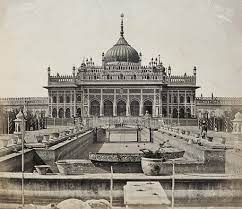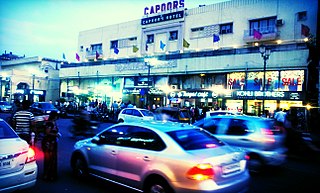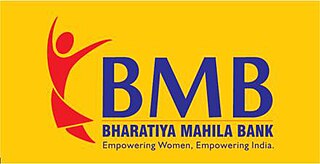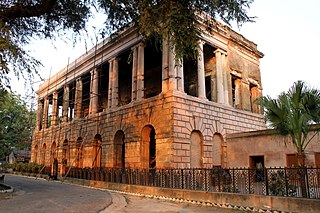
State Bank of India (SBI) is an Indian multinational public sector bank and financial services statutory body headquartered in Mumbai, Maharashtra. It is the 48th largest bank in the world by total assets and ranked 178th in the Fortune Global 500 list of the world's biggest corporations of 2024, being the only Indian bank on the list. It is a public sector bank and the largest bank in India with a 23% market share by assets and a 25% share of the total loan and deposits market. It is also the tenth largest employer in India with nearly 250,000 employees. In 2024, the company’s seat in Forbes Global 2000 was 55.

Wazirabad is a city in Punjab, Pakistan. It is the administrative capital of Wazirabad District.

State Bank of Hyderabad (SBH) was a regional bank India, with its headquarters at Gunfoundry, Abids, Hyderabad, Telangana. Founded by the 7th Nizam of Hyderabad State, Mir Osman Ali Khan, it is now one of the five associate banks of State Bank of India (SBI) and was one of the nationalised banks in India. It was established on 8 February 1941, as the Hyderabad State Bank. From 1956 until 31 March 2017, it had been the largest associate bank of the SBI. After formation of Telangana in 2014, SBH was the lead bank of the newly created state. The State Bank of Hyderabad was merged with State Bank of India on 1 April 2017.

Modern banking in India originated in the mid of 18th century. Among the first banks were the Bank of Hindustan, which was established in 1770 and liquidated in 1829–32; and the General Bank of India, established in 1786 but failed in 1791.

Begum Hazrat Mahal, also known as the Begum of Awadh, was the second wife of Nawab of Awadh Wajid Ali Shah, and the regent of Awadh in 1857–1858. She is known for the leading role she had in the rebellion against the British East India Company during the Indian Rebellion of 1857.

Satna is a city in the Indian state of Madhya Pradesh. It serves as the headquarters of Satna district. It is 7th largest city and 8th most populous city of the state. The city is 500 km east of the state capital Bhopal. The city is distributed over a land area of 111.9 square kilometres.

The Khanate of Kalat, also called the BrahuiConfederacy, was a Brahui Khanate that originated in the modern-day Kalat region of Pakistan, ruled over by the Brahui Ahmadzai dynasty till 1948. Formed in 1666 due to the threat of Mughal expansion in the region, it controlled the wider Balochistan at its greatest extent in the mid-18th century, extending from Kerman in the west to Sindh in the east and from Helmand River in the north to the Arabian Sea in the south. The Khanate of Kalat lost considerable area to Qajar Iran and the Emirate of Afghanistan in the early 19th century, and the city of Kalat was itself sacked by the British in 1839.

The Capture of Lucknow was a battle of Indian rebellion of 1857. The British recaptured the city of Lucknow which they had abandoned in the previous winter after the relief of a besieged garrison in the Residency, and destroyed the organised resistance by the rebels in the Kingdom of Awadh.

Koti is a locality in the city of Hyderabad, Telangana, India. It is one of the best-known commercial old suburbs of Hyderabad. There are two areas in the vicinity: King Koti and Ram Koti.

The Chattar Manzil, or Umbrella Palace is a building in Lucknow in Uttar Pradesh which served as a palace for the rulers of Awadh and their wives.
Mohan is a town and a nagar panchayat in Unnao district in the Indian state of Uttar Pradesh.

The Lucknow School of Architecture was an experiment by the resurgent Nawabs of Awadh. It was an attempt to preserve the Mughal school of architecture by experimenting with different materials and innovating new concepts.

Dilkusha Kothi is the remains of an eighteenth-century house built in the English baroque style in the quiet Dilkusha area of Lucknow in India. Today there are only a few towers and external walls as a monument, though the extensive gardens remain. The house was shelled during its involvement in the Siege of Lucknow in 1857, together with the Residency and the nearby school of La Martinière.

Narnala Fort or Narnala Qila Sarkar, also known as Shahnoor Fort, is a hill fortress in the Satpura Range of Vidarbh, Maharashtra, India, named after the Rajput Solanki Chaulukya Ruler, Raja Narnal Singh, also known as Narnal Singh Swami. It was renamed as "Shahnoor" by Islamic rulers but again acquired, rebuilt and got its name "Narnala" by ruler Rao Rana Narnal Singh Solanki, who migrated from Patan in Gujarat.

Hazratganj, is the downtown and main shopping hub of Lucknow, the capital and largest city of the Indian state of Uttar Pradesh. In addition to bazaars, it also contains shopping complexes, restaurants, hotels, theatres, cafés and many offices.
The Alliance Bank of Simla was a British-run though India-registered bank that commenced operations in Simla in 1874 under the management of James Lewis Walker. The bank was established to take over the business of the United Bank of India, established in 1866, which had operations in Simla and Umballa. Its board put the United Bank of India in voluntary liquidation on 21 March 1874, and Alliance Bank commenced operations two days later. After 49 years, Alliance Bank failed on 27 April 1923 due to speculation by its management. At the time that it failed it had 36 branches, including ones in Lahore, Lucknow, Peshawar, Rawalpindi, and Rangoon.

Jind State was a princely state located in the Punjab and Haryana region of north-western India. The state was 3,260 km2 (1,260 sq mi) in area and its annual income was Rs.3,000,000 in the 1940s. Jind was founded and ruled by Jat Sikh rulers of Sidhu clan.

Bharatiya Mahila Bank was a fully owned subsidiary of State Bank of India based in Mumbai, India. Former Indian Prime Minister Manmohan Singh inaugurated the system on 19 November 2013 on the occasion of the 96th birth anniversary of former Indian Prime Minister Indira Gandhi. As part of the Modi government's banking reforms and to ensure greater banking outreach to women, the bank merged with State Bank of India on 1 April 2017.
Lucknow is known as a city of imambaras as it contains a large number of them, among which, some are very well known.

Bibiyapur Kothi is a historic building in Lucknow, India. Built by Asaf-ud-Daula, Nawab of Awadh, the residence is now administered by the Indian Army.



















